
When buying solar or batteries, or both, it is easy for a technical nuance to be overlooked. Sub-optimal decisions at the design stage affect the performance and savings for the life of the system – typically 25 years or more.
If you are technically minded, it makes sense to school yourself in the most common technical mistakes made when specifying residential solar so you can intelligently talk to your installer or salesperson about the system design that they will be quoting.
This post is deliberately more technical than the popular ‘Seven Solar Mistakes‘ article written by Finn and its follow-up ‘The Next Seven Solar Mistakes‘ written by ex-installer Kim just last week. If you are not of a technical bent, then both of those posts will be helpful. But if you enjoy getting deep into the technicalities, this is the post for you.
These are the seven technical mistakes I’ve seen people make when buying solar and/or batteries, written from the perspective of 20 years’ experience as a solar power system designer and installer in South Australia.
Tech Tip #1: Solar Panel Direction & Pitch
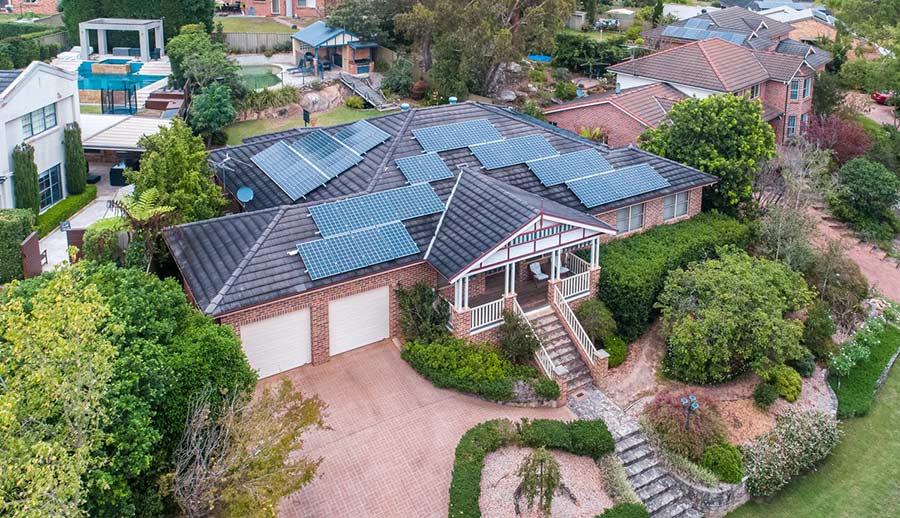
Image Credit: Penrith Solar Centre
Solar panel direction and pitch (angle from horizontal) are the bread and butter of your energy production. Long-term cumulative value will be gained or lost depending on your decision here. Finn has published a great overall summary of different roof mounting directions, and these technical rules of thumb can be added to it:
Note: The % losses here are not precise, but should give you a good feel of the comparative losses.
Rules Of Thumb: For North Facing Panels
- Panel Direction: within 10º of north1
- Panel Pitch: from 15º under to 5º over your latitude
- Energy Yield: if you follow these rules expect less than 2% loss (compared to the perfect orientation)
e.g: for Adelaide (latitude 35º): Face panels NNW to NNE, at an angle of 22º to 40º from horizontal for less than 2% loss in annual energy production.
Rules Of Thumb: For East/West Facing Panels
- Panel Direction: Generally, west gives ~1% more energy than east
- Panel Pitch: Flat (0º) up to the angle of your latitude
- Energy Yield: Expect 13% loss at shallow pitches to 20% loss at the higher pitches (compared to the perfect orientation)
Rules Of Thumb: For South Facing Panels
- Panel Direction: As a long-time installer, south scares me. Shading mitigation is critical – see notes on shading further down.
- Panel Pitch: Flat (0º) up to the angle of your latitude
- Energy Yield: Expect 13% (low pitch) to 40% loss (high pitch) -compared to the perfect orientation
Tech Tip #2: Summer Vs Winter Output

The winter sun is lower, so you’ll get more winter energy with a steeper panel pitch and vice-versa.
Rule Of Thumb: Optimising Pitch For Summer Or Winter Generation
- The closer to horizontal, the higher the summer output vs. winter output.
- The closer to vertical, the higher the winter output vs. summer output.
These rules are useful for off-grid systems, where winter power is at a premium. Off-grid systems often benefit from steeper panel angles.
For on-grid systems, these rules can be useful depending on your winter and summer loads.
Tech Tip #3: Shade
Shade is the single biggest factor that determines your overall energy losses. A good designer will work out the best unshaded positions for your solar panels.
Become acquainted with where the sun is on your roof – for all times of the year. Ask your solar salesperson for her company’s estimation of your loss from shade on their quote. More involved shading may warrant a shade-survey, using a proprietary measuring device such as a SunEye or Solar Pathfinder.
If ever there was a category for heartbreak-in-sympathy-for-the-customer, then this is it. A competent installer, on a 20-minute drive in the suburbs, could point to numerous solar panel arrays with severe shade compromise. Shadows have a disproportionate effect on the losses experienced by solar panels; even small, thin shadows of twigs can cause major output losses.
Here are some typical shade-objects causing shadow problems; some obvious, some not:
- vegetation close-in to the panels,
- very tall trees to the direct north,
- double-storey next door on the north side,
- antenna, sewer-vent or chimney to the immediate side of the panels,
- panels mounted deep in the valley of a double-peak roof.
I hope that the salespeople for these systems all gave accurate forecasts of the shade losses. Below is an example of where the panels behind the pencil-pines will have reasonable power output in summer, but very poor in winter due to the pencil-pine shadows all through the day.
Rules Of Thumb: For Shaded Solar Panels
- The closer a shading-object is to the panels, the longer it will cast shade.
- Shading-objects to the east or west of the panels will cause more shading in summer than winter. It is generally better to cop some shade in winter rather than in summer, as the equivalent time spent in shade in summer has proportionally higher losses than winter.
- Sun-hours from end-of-dawn until beginning-of-dusk are the most important for solar electricity production – so a small shadow passing in the middle of the day can have a significant effect on solar energy output at that time.
- Imagine your eyes are placed at the level of the lowest solar panel on your roof – this gives you the same line of sight of the panel. Now look to where the sun gets up above the local horizon (i.e. local buildings and trees in the distance) in the morning, and follow the sun-path across to your local horizon in the west. If there is no tall object crossing the path of the sun during the day, then you have no shade problem.
Shade surveys: Good solar companies have the ability to undertake a shade survey from your roof. Usually, a special device is used, but an app on a smart-phone could be used too. The shade survey results give total annual solar production losses due to shade on your roof. In turn, this provides a forecast of the monthly output of your system – the Clean Energy Council has ruled that your solar supplier should provide this to you as part of your sales order.
South-facing special note: If there is really no shade to speak of, then no problem. However, as soon as the roof pitch moves from flat (0º), to tilted toward south, even 3º pitch, then any impinging shadows become disproportionately long. So any antenna, or chimney, or vent on the roof, suddenly starts spending a lot more time sitting on your south-facing panels.
In my time, I have found it difficult to get a patch clear of these sorts of shadows on a south roof – I think it cannot be achieved that often in a typical suburban setting. Get a shade survey done early if you are thinking of going south!
Tech Tip #4: When To Use Optimisers/Microinverters For Shade Mitigation
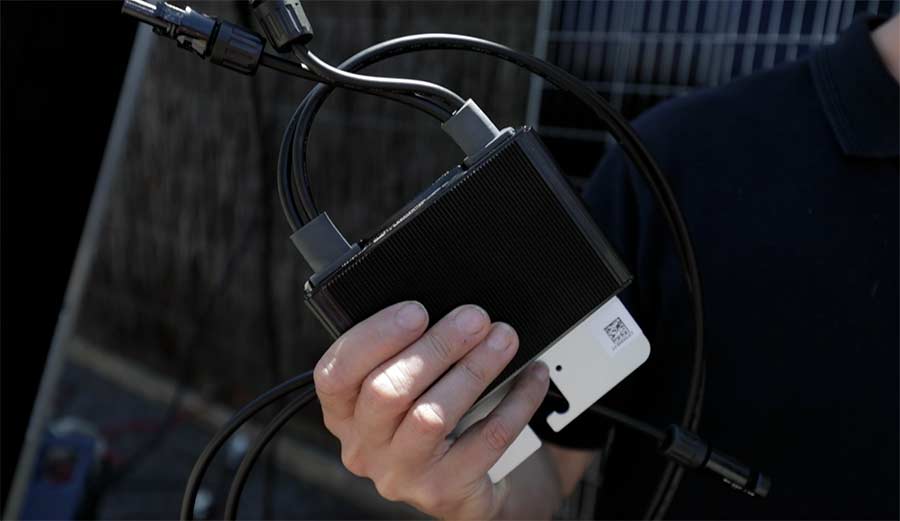
Should you pay extra for an optimiser like this for every panel?
All panels have some shade-mitigation technology. Be careful splashing out on advanced optimisation, as in some cases, the additional cost of advanced ‘shade-combat’ technology returns very little, investment-wise.
If you have shading issues on your roof and are considering paying extra for optimisers or microinverters, it makes sense to understand how much more energy you will get for the extra hardware dollars.
You might think that if one panel is in 20% shade, from an array of ten panels, then the production loss is 20% divided by 10, which is 2%. Well, no – it may be ~8 to 10% depending on what type of technology is used:
- inside the panel itself
- in any external panel optimisers or microinverters
- in the algorithm that the inverter uses to detect shade
Some of this technology comes built-in as standard, others are available as more expensive panels, or more expensive inverter/optimisers/microinverters.
Rules Of Thumb: Buying Extra Optimisation
- If the panels are unshaded from 8am to 5pm most of the year, you’ll get good yield without spending on extra optimisation technology.
- If there are some shadows intruding from 8am to 5pm, for some of the year, it is a possible candidate for additional optimisation technology – do your costings with the sales rep.
- With four or more hours of shading from 8am to 5pm, for almost all the year, no tech can save you. To put panels in only half the sun is dumb – at least from an economic standpoint.
Tech Tip #5. Cable Sizing
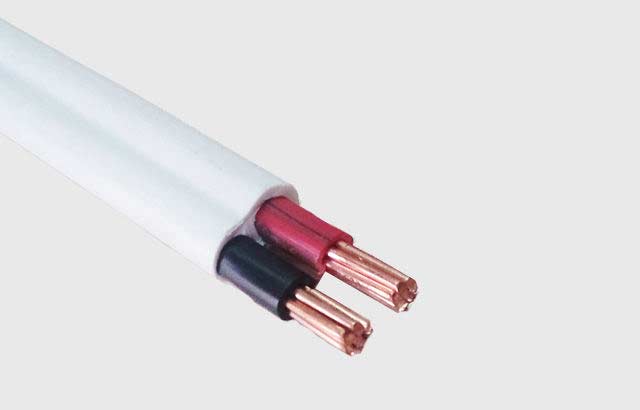
The thickness of your power cables is important.
Your designer must take care to ensure the following cables in your system are not undersized:
- the cables used to connect your solar inverter to your switchboard; and
- the cables from your electricity meter out to the powerlines in the street.
If undersized, you risk exporting less solar power, as your inverter will regularly drop its power output when it senses the voltage rising too high due to the higher resistance of those skinny cables.
Ask for a statement to be included in your sales contract, that says the designer and installer are satisfied that your new solar power system will not cause any more than 1% voltage rise from each of:
- the inverter to the electricity meter,
- and the electricity meter to the premises service fuse (which is the official mains connection point)
Why is cable size a big issue for solar?
At times, the voltage in your street will get very high. This typically happens when there is a lot of sun in cooler weather. On mild, sunny days, home cooling or heating is not required and everyone’s solar power system is pumping out a lot of export.
The more rooftop solar power that is installed across the suburbs, the greater the incidence of voltage rise in power lines in the streets.
In response to this, the Australian Standards committee for grid-connected solar inverters have set a limit on the operating mains voltage for all new installations, as sensed by your inverter. It is set to curtail and limit the inverter’s production in times of high street voltage.
Rule Of Thumb: Cable Sizing
If your inverter has a too-skinny cable that allows more than 1% voltage rise, the inverter will experience more time when it is limiting its export.
Tech Tip #6: Battery Sizing
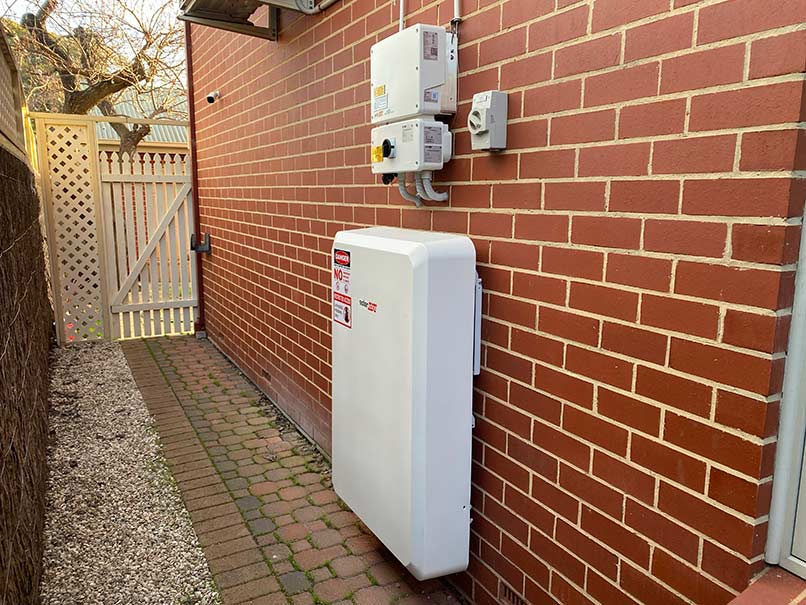
A SolarEdge 10 kWh home battery.
Do you have enough solar to charge the battery in winter?
To optimise the economic value of a home battery you must minimise the number of days in the year when it does not fully charge from your solar panels. In other words, you must ensure you have enough solar electricity production in winter to charge your battery.
Plan to have enough solar energy available during winter for your selected battery. If you are restricted in the size of solar system you can install, then this in turn sets the most economic size battery you can install.
The first part of battery sizing involves calculating what spare solar you have during each season.
If you have solar panels already, you can easily see from your bill or your consumption monitoring the average kWh of solar electricity exported to the grid over winter. This is how much surplus solar you have to charge your future battery.
If you don’t have panels, then you can get a daily winter solar energy estimate from the SQ solar and battery calculator.
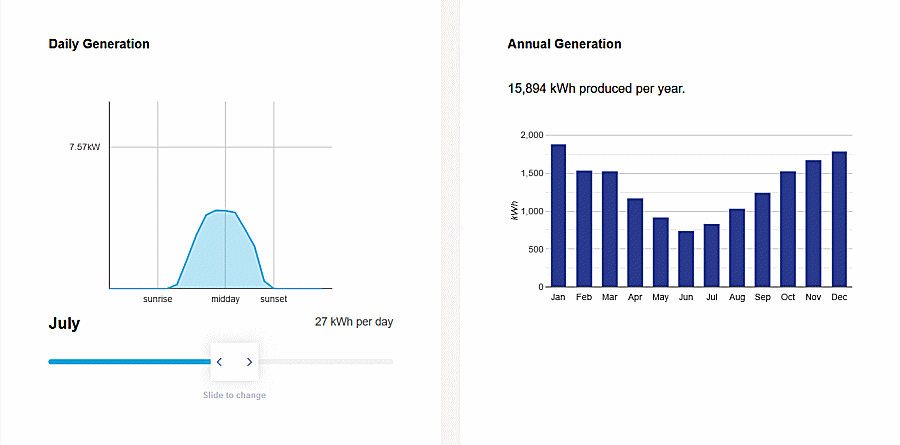
SQ solar calculator results: Predicted generation for a 10 kW, north-facing system in Adelaide
If you subtract your typical winter daytime energy use from your average winter solar generation, you’ll have a good estimate of how many surplus kWh of solar electricity you’ll have per day to charge your battery.
Example: You have a 10 kW solar power system that generates 20 kWh of solar on an average winter’s day. Your winter daytime usage is 16 kWh per day, so you can fully charge daily a 4 kWh battery from May to July. Of course, for the rest of the year you may have closer to 20 kWh export spare, so installing a Powerwall-sized 13 kWh battery makes use of this, but it only gets charged to 4 kWh or so for the three winter months. Buying the 13 kWh battery is a valid decision, as long as you realise how this will work, before signing up.
How much energy do you use overnight?
Assuming you have enough solar to charge your battery to full capacity each day, then the best economics are served by a battery no larger than what you use overnight, for the majority of nights of the year.
What is your nighttime usage, for each season of the year? Ideally, you would need to take readings from your electricity meter or monitoring.
Let’s say that your total usage is 24 kWh per day, and your daytime usage is 16 kWh
24 kWh minus 16 kWh (daytime usage) = 8 kWh (overnight usage)
Therefore an 8 kWh battery would cover your overnight usage – provided you had enough spare solar energy production during daylight to put 8 kWh into the battery.
In this case:
- If it was winter, and there were only 4 kWh available to charge the battery, then it only cover 4 kWh of your 8kWh night usage
- Any battery capacity in excess of 8 kWh will hardly be accessed.
Don’t forget to reserve some kWh for blackout protection
Recognising this is not an off-grid system, we then do not necessarily need a high degree of reserve. But it is always nicer to have more battery capacity if we can always fill it.
So why not size our battery to cover *all* overnight consumption in winter; then we should not have to worry if there was a 6-hour power cut anytime. The battery is sized for our 24-hour consumption assuming average sun for the time of year achieves sufficient battery recharging. It effectively becomes a ‘full’ off-grid system in a blackout.
The exception is three or more dark days in winter – then by all means make the battery a bit larger if you want to cover this.
Tech Tip #7: Cost Of Generation/Storage Vs Cost Of Efficiency
In a perfect world, we would all have super-efficient homes. Then the optimal size of solar and battery (in ROI terms) would be matched to the house consumption.
In the real world, our homes could almost all be improved to make them more efficient by improving the thermal envelope (gaps, glazing and insulation) and getting more efficient appliances.
So, to get your bills down, should you spend your money on bigger solar and more storage, or should you buy a conservatively sized solar system and invest in energy efficiency?
To answer this you must work out what uses the most energy in your home and whether you use the most power in summer or winter. In either case, the answer is usually heating or cooling, but perhaps you have a swimming pool, or some other special equipment using lots of electricity.
Then, ask yourself, “What sort of money would be required to turn this large use of electricity into a smaller one?” – and ideally, how many kWh would you save.
You can see where this is going. You may need to spend $20,000 on a decent solar and battery system to suit your energy usage right now, but if you spend $4,000 on efficiency, and the reduced consumption only requires a $13,000 system to achieve the same bills, you’ve saved $3,000 for the same result.
Also, look at the lifetime and qualitative benefits of any remediation spend. Money spent on improving thermal efficiency should last the life of the building (and make a healthier & more comfortable home) whereas battery capacity is degraded somewhat after about 8 years.
Conversely, costs of remediation that are noticeably above that of applying more solar power or battery give you the confidence to go ahead and install it!
Footnotes
- In southern hemisphere ↩

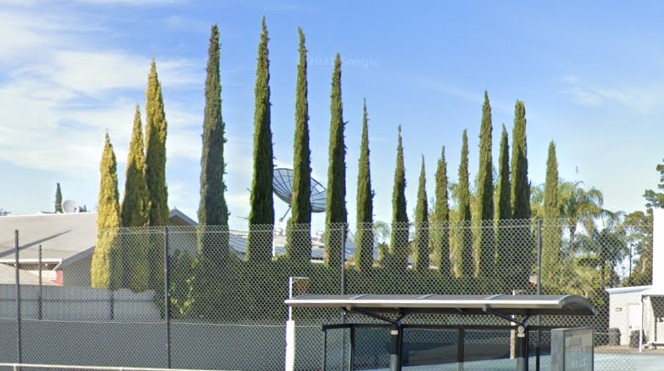

 RSS - Posts
RSS - Posts



Great article, Chris – will try to remember details for when I’m next in the market for PV.
Query your example of an 8kWh battery not being accessed though. If you had a bigger battery that retained 4kWh after the previous night, then adding only 4kWh would provide enough to power the current night. This might happen a lot in winter?
“a bigger battery that retained 4kWh after the previous night”
Hi Ian – Yes, it may happen sometimes, but winter has a bit less than half the annual average of solar. So over the course of winter, there really isn’t much excess from day to day.
It is possible to increase solar panels to increase the probability of retaining more in a larger battery.
Overall sizing caters for averages, rather than exceptions. Good question.!
Hi Chris
Taking your sizing vs averages comments one step further – this has to be the argument for why it is safer to stay on the grid, regardless.
I see some people are off-grid, but they invariably include a FF generator in the mix – to cover those ‘exceptions’ you mention. Otherwise, they would need very significant oversizing of PV, and of batteries – to make it through the cold, dark nights of mid-winter.
So – I see Australia as a whole, as being off-grid – presently, we have to generate what is demanded, at all times – or face rolling blackouts if we get this equation wrong (or, even ‘State-black’, like SA had). Once coal, NG, diesel, and petrol are eliminated – we will need a system that can cater for the worst-case exceptions. I can’t imagine either, that we would be likely able to power the whole of NSW, for example, from huge batteries and wind farms located in our Pilbara region – the costs of very-lowly-utilised but massive transmission line capacities, and of very-lowly-utilised and massive batteries, would seem to me, at least, rather prohibitive.
This is where people are getting it all wrong – it is much, MUCH easier to integrate moderately large quantities of VRE, when we have coal and NG to back us up – as we have now – than it is to do all this with batteries, and no FF. It is the exceptions that will kill us. This is not to say we should not have massive rooftop PV investment – we obviously should. But if we cannot easily go off-grid, nor can Australia as a whole.
I firmly believe we need to be getting our heads out of the sand – time is getting away from us (if it hasn’t already)…!
Hi Chris
I am looking at getting a battery and looking at the Tesla powerwall 2. I have been told that because I have a 3 phase inverter that I would need to get a second single phase inverter as the 3 phase will not charge the battery during a blackout. I have a 13kw system and was wondering if this was feasible or maybe not to bother with the extra expense as usually when we have lost power it was for no longer than 12 to 18 hours. I would like to know your thoughts on this.
Thanks
Hi, I have 5kw installed on my roof, but I have serious shading issues. My winter electricity bills are quite high. I live on acreage, and have plenty of room for ground based solar panels, but have no idea if anyone makes these or installs them. Can you advise?
Hi Eric
I have some good news and some bad news. The good news is ground mounts can work well for people with room for them and, if desired, they can be angled to improve winter output. It also makes cleaning and maintenance far easier. For rural properties it can have the big advantage they can allow solar to be located near the grid connection point, which can be very important. The bad new is, it adds a lot to the cost of a solar system. How much will depend on system size, location, and wind zone. Some people who have considered it have decided it was more cost effective to put solar on a roof that’s sub-optimal for solar production or to build a new shed and put solar on that. (This only makes sense for those who’ll benefit from having a new shed.) At best, you can expect to pay a minimum of +$400 per kilowatt for a ground mounted 6-10 kilowatt solar system. But it may cost much more.
Chris, great tips and info, particularly the orientation stuff. Thanx. 🙂
We will not be buying a battery. Instead, we use the grid as a virtual battery. Our 13.2kW/10kW system produces over 9kWh of exports in an average year (81% of our generation), of which we “buy back” 4.5kWh at a premium of 16.6c/kWh in imports, for which we pay $747pa. The other 4.5kWh earns an FiT of 13c/kWh, a total of $585 pa, so we only pay $162 in electricity costs pa.
So, it’s easy to see that batteries are simply not a sensible economic proposition currently. We’re looking forward to vehicle-to-grid (V2G) EVs and infrastructure in the future so we can plug our next-generation EV into the grid and be an even greater part of the solution!